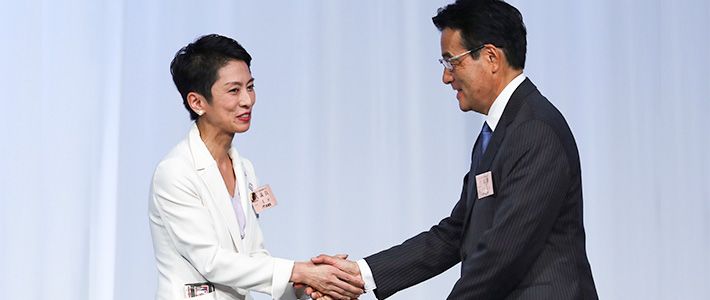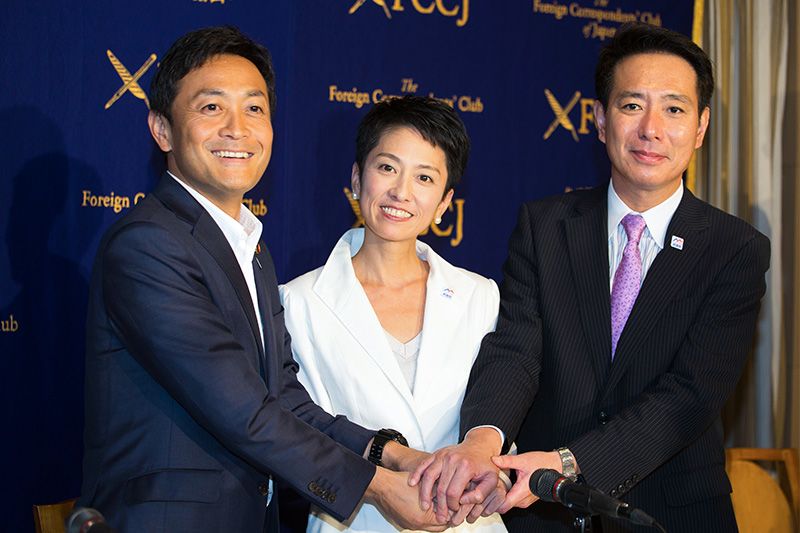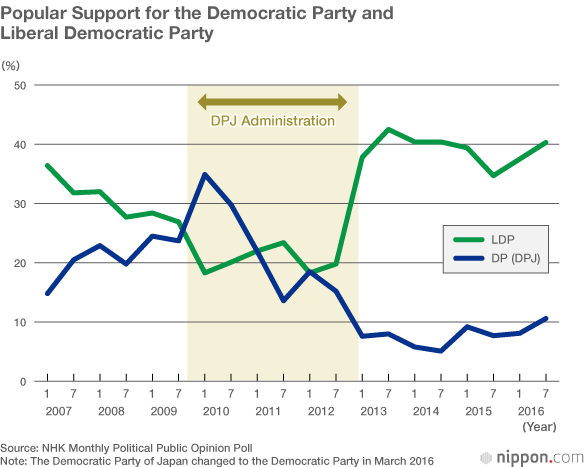
Democrats Elect Renhō as Party President
Politics- English
- 日本語
- 简体字
- 繁體字
- Français
- Español
- العربية
- Русский
On September 15 Renhō won a three-year term as president of the Democratic Party, becoming the first female head of the main opposition party. Not since Doi Takako controlled the Japan Socialist Party (today the Social Democratic Party) in 1986–91 has a woman led a party with over 100 Diet seats. The Democrats are looking to Renhō to restore the party’s image following meager showings during the last few election cycles. The three-term member of the House of Councillors is confident she can rebuild the DP as a force to counter the ongoing dominance of the Liberal Democratic Party, saying, “We are not aiming to be an opposition party, but one that people look to for its ideas and to provide a new direction for the nation.”
An Emphasis on Investing in People
Renhō, the deputy chief of the DP, headed into the leadership election with broad backing throughout the party. In the first round of balloting she garnered nearly 60% of votes to easily overcome the other candidates, former Foreign Minister Maehara Seiji and DP chief for Diet affairs Tamaki Yūichirō.
Support for her bid centered on her own faction, led by former Prime Minister Noda Yoshihiko, and also included senior party officials like outgoing DP President Okada Katsuya and former Chief Cabinet Secretary Edano Yukio. Roughly half of the party’s 147 Diet members chose to back Renhō, including many from the liberal arm of the DP, former Democratic Socialist Party members, and those in the faction led by former Minister for the Environment Hosono Gōshi.
During campaigning Renhō worked to draw a clear line between her ideas and those of Prime Minister Abe Shinzō. She argued the need to expand policies that “invest in people” by stressing increased spending on education and other measures that would boost economic growth, changes she said she would fund through reform of public finances. She also stood behind retaining the cooperative framework Okada spearheaded among the Democrats, Japanese Communist Party, Social Democratic Party, and People’s Life Party & Taro Yamamoto and Friends during the last election. Concerning a potential bid by the LDP to change the Constitution, Renhō said she is open to debating the issue, but is determined to maintain an unamended Article 9, which renounces Japan’s right to wage war and maintain armed forces.
As party head she will have her sights set on becoming prime minister. However, she is a member of the upper house; the common wisdom says she must first capture a lower house seat to become eligible, which she said she is prepared to do.
 From left, Tamaki Yūichirō, Renhō, and Maehara Seiji shake hands during a press conference at the Foreign Correspondent’s Club in Tokyo on September 14, 2016. (Photo by Ōtani Kiyohide.)
From left, Tamaki Yūichirō, Renhō, and Maehara Seiji shake hands during a press conference at the Foreign Correspondent’s Club in Tokyo on September 14, 2016. (Photo by Ōtani Kiyohide.)
A Former Model with Taiwanese Roots
Renhō was born Hsieh Lien-fang in Tokyo in November 1967 to a Taiwanese father and Japanese mother. According to her 2010 autobiography, Ichiban janakereba dame desu ka (Do You Have to Be the Best?), her father ran a company that imported bananas from Taiwan and in elementary school she spent every summer holiday on the island.
Although she grew up in Japan, it was not until age 17 that she took citizenship following a 1984 amendment to the Nationality Law extending citizenship to children of Japanese mothers, not fathers alone, and requiring holders of multiple nationalities to select one by age 22. She made her debut as a model in 1988 while a student at Aoyama Gakuin University, posing in advertisements by audio maker Clarion. She also appeared on variety shows and other television programs. Renhō switched her focus to journalism in 1993 after taking over as anchor of TV Asahi’s news program Station Eye.
In July 2004 she was elected to the upper house from Tokyo after being tapped to run by influential Democrats Sengoku Yoshito and Tezuka Yoshio. After the party, then still known as the Democratic Party of Japan, came to power in 2009 under Hatoyama Yukio, she served as a key figure in a sweeping review of government programs, forging a reputation as a tough negotiator with her direct way of speaking and firm mannerisms. In one incident that drew national media attention, she relentlessly raked researchers over the coals when questioning the practicality of an Education Ministry-backed program to develop a next-generation super computer.
In 2010 she joined the cabinet, serving through 2012 in various posts, including as minister of state for government revitalization. She took over as deputy chief of the party after it merged with the smaller Japan Innovation Party in March 2016.
Renhō has built a distinct political career using her strong personality and sharp oratory style, reflecting in her autobiography that “I was raised to speak my mind.” Her propensity for straight talk, however, has also worked against her at times, such as when she called Okada “a bore” after announcing her bid for the party presidency.
The issue of dual citizenship briefly became an issue for her candidacy after she admitted she still held Taiwanese nationality despite her earlier assertion that she had relinquished it.
She started going by Renhō while working as a model, but her legal name since marrying in 1993 has been Murata Renhō. She has two children, a twin son and daughter.
High Hopes Among Party Members
The Democrats are the main opposition in the Diet, but the party has yet to fully recover since being swept out of power in 2012. It was weakened by such incidents as its bungling the issue of relocating the US Marines Air Station Futenma in Okinawa and internal bickering. In March the party looked to boost its appeal by merging with the JIP and rebranding itself under a new name. Despite the move, though, national support for the DP continues to hover around 10%.

Renhō brings with her a reputation as a strong leader that the party hopes she will use to guide it back to a position to challenge the LDP for power. In her first term as president she will oversee a lower house election in December 2018. Her success at the helm of the DP will come down to both the message she projects and her ability to square off against the LDP led by Abe.
(Banner photo: Outgoing Democratic Party head Okada Katsuya, right, shakes hands with Renhō following her election as the new party president in Tokyo on September 15, 2016. © Jiji.)